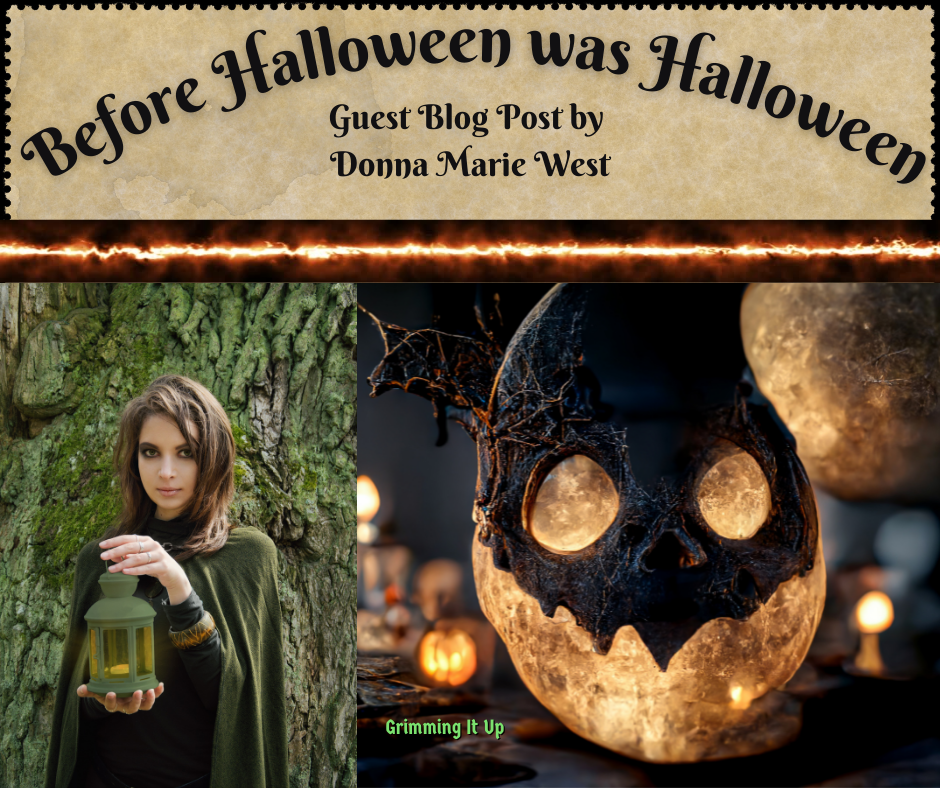
This is another guest post by Donna Marie West, where she shares some of the histories of Halloween or Samhain.
. . . It was a Celtic solar festival called Là Shamhna, commonly known today as Samhain.
Samhain, which means “end of summer,” marked the final harvest and the storage of food for the winter. The Celts believed this to be a magical time when the veil weakened between the worlds of the living and the dead. They imagined all manner of spirits, goblins, and fairies walking among the people. The ghosts of the dead rose to play tricks on the living, causing sickness and even destroying crops in the field. In order to fool these malevolent entities, people wore masks or straw hats, dressed in disguises, or painted their faces black.
Feasts and Festivities
Celtic villages held feasts and made offerings of food and wine to the Lord of the Dead in
hopes that he would be kind to the souls of the deceased. They made offerings to the dead themselves so that they would cause less mischief to the living. If anyone dared steal or snack on this specially reserved food, they would, upon their own death, become a hungry ghost that would not be welcome at future Samhain feasts. A custom in some villages allowed the poor to go to the homes of the wealthy, receiving offerings in the names of their ancestors and collecting some of the food set aside for the dead for their own use.
Another important part of the Samhain celebration was the village bonfire, where
townspeople threw grain and live farm animals into the flames as a sacrifice to the Celtic gods. As night ended, people relit their household fires from the remains of the sacred bonfire. The evening wasn’t all solemn ceremony, however. People told stories, sang, and danced the night away. Children played games such as bobbing for apples. Druids (the Celtic priests) told adults their fortunes by peeling an apple, throwing the peel over the person’s shoulder, and reading its shape, which might, for example, form the first letter of their future wife or husband’s name. Other methods made use of nuts and egg whites to predict things such as whether a couple would stay together or how many children a woman would have.
The Catholic Church Gets Involved
In the 8th century CE, the Catholic Church made November 1 an official holiday called All
Saints’ Day. October 31 became All Hallows Eve and, eventually, Halloween. The Church insisted that although there were no spirits or fairies to frighten away, people could continue dressing in costumes to honor dead saints. Remembering the dead with prayers instead of sacrifices was encouraged. Small, sweet buns decorated with currants or other fruit, called “soul cakes,” were given to the poor people of the village, who in turn prayed for the dead. In some communities, peasants went from door to door, not for candy but for money, bread, cheese, eggs, nuts, and apples.
Trick-or-Treat is Born
When immigrants from Great Britain and Europe colonized America, they brought their
traditions with them. The practice of collecting food door-to-door eventually became trick-or-treating. Bonfires became hearth fires, and ritual feasts became parties with snacks, fun, and games. It wasn’t until the 1930s, however, that Halloween grew into a popular and widespread festivity. Today, it’s happily celebrated by trick-or-treating children not only in the US, but Canada, Australia, Mexico, Ireland, and the United Kingdom.
Thanks for spending time with us!
Some final thoughts: First, we’re so glad you stopped by.
Next, if you want to read on, we have some other creepy posts you might enjoy, like “The Raven” by Edgar Allan Poe or “The Tell-Tale Heart” by Poe. If you enjoyed this post, these others might also be right up your alley.
Lastly, we hope to see you again soon.
BIBLIOGRAPHY OF SOURCES
Guiley, Rosemary Ellen. THE ENCYCLOPEDIA OF GHOSTS AND SPIRITS. Checkmark Books,
New York, NY, 1992
MacCulloch, J.A. THE RELIGION OF THE ANCIENT CELTS. 1911. Reprinted by Dover
Publications, Mineola, NY, 2003
Pennick, Nigel. THE SACRED WORLD OF THE CELTS. Inner Traditions International, Rochester,
Vermont, 1997
Internet sites: www.halloweenhistory.org
www.imbas.org /articles (Kondratiev, Alexei. SAMHAIN: SEASON OF DEATH AND
RENEWAL. 1997)

